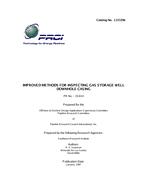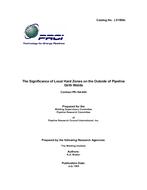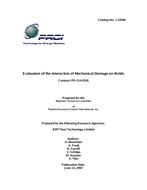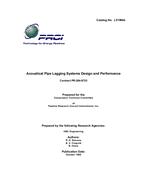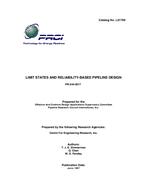Provide PDF Format
PRCI PR-15-614
- Improved Methods for Inspecting Gas Storage Well Downhole Casing
- Report / Survey by Pipeline Research Council International, 01/01/1987
- Publisher: PRCI
$198.00$395.00
L51539e
Southwest Research Institute
Need: A considerable background of prior work indicates that corrosion damaged casing in gas storage wells is largely due to the development of individual corrosion pits, which occur either on the inside or outside wall of the casing. Such pits are inevitably the result of electrochemical potentials, which are established between unlike conductive materials in an electrolyte. Damage is the result of localized loss of metal, which can be assessed in terms of the size of these individual corrosion flaws. Magnetic corrosion logging has been available for at least 25 years, but has not received wide acceptance as a basis for making intelligent repair decisions. An earlier PRCI-sponsored research study concluded that the best approach to short term improvement in the performance of current corrosion logging practice was the application of modern digital data acquisition techniques to one specific type of magnetic logging, namely, flux leakage or magnetic perturbation measurements.
Result: In this research program, experimental equipment of this type has been developed and demonstrated in conjunction with a cooperative effort with one of the logging companies (Dresser-Atlas). This equipment replaces the electronics assembly in the commercial instrument with a new package which samples each of the 12 (or 24) analog flux leakage sensor signals at a rate of either 86.8 or 173.6 samples per second, depending upon whether 24 of the sensors or only 12 are being sampled. The signals are digitized at this rate under the control of a downhole microprocessor, which formats
the digital data into a serial bit stream and transmits it to the surface over standard logging cable. The data transmission system uses Manchester encoding and performs the data transfer at a maximum rate of 40,000 bits per second.
Benefit: At the completion of the project, the equipment is fully operational over short lengths of cable. With relatively minor additional development, data transmission capabilities could be extended to long cables and logs run under actual field well conditions.
Southwest Research Institute
Need: A considerable background of prior work indicates that corrosion damaged casing in gas storage wells is largely due to the development of individual corrosion pits, which occur either on the inside or outside wall of the casing. Such pits are inevitably the result of electrochemical potentials, which are established between unlike conductive materials in an electrolyte. Damage is the result of localized loss of metal, which can be assessed in terms of the size of these individual corrosion flaws. Magnetic corrosion logging has been available for at least 25 years, but has not received wide acceptance as a basis for making intelligent repair decisions. An earlier PRCI-sponsored research study concluded that the best approach to short term improvement in the performance of current corrosion logging practice was the application of modern digital data acquisition techniques to one specific type of magnetic logging, namely, flux leakage or magnetic perturbation measurements.
Result: In this research program, experimental equipment of this type has been developed and demonstrated in conjunction with a cooperative effort with one of the logging companies (Dresser-Atlas). This equipment replaces the electronics assembly in the commercial instrument with a new package which samples each of the 12 (or 24) analog flux leakage sensor signals at a rate of either 86.8 or 173.6 samples per second, depending upon whether 24 of the sensors or only 12 are being sampled. The signals are digitized at this rate under the control of a downhole microprocessor, which formats
the digital data into a serial bit stream and transmits it to the surface over standard logging cable. The data transmission system uses Manchester encoding and performs the data transfer at a maximum rate of 40,000 bits per second.
Benefit: At the completion of the project, the equipment is fully operational over short lengths of cable. With relatively minor additional development, data transmission capabilities could be extended to long cables and logs run under actual field well conditions.

